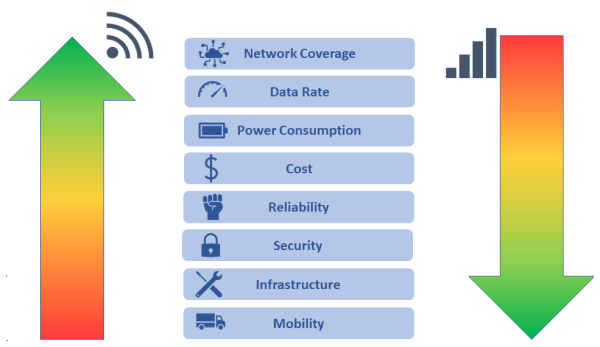With the ubiquity of wireless connectivity options on IoT devices, connection to the cloud has become more flexible than ever. Traditionally, Wi-Fi has been the most popular choice in the IoT world although this has changed in recent years with the huge strides made in cellular networks. However, there is no right answer for which option would be the best or the more efficient between the two.
The type of network connection to use depends on several factors that affect solution development.
Network coverage plays a key role in connectivity selection. Though LTE has gained a fair share of popularity, in many regions cellular network options are scarce, limiting the choice for users. Between LTE-Cat-M1 and NB-IoT, most regions support only one of the two so, Wi-Fi has proven to be a convenient connectivity choice due to its universality.
Data rate, may not be a compelling factor for connectivity choice on IoT devices, but still plays its part in the showdown. Cellular network data rates constantly improve with the introduction of new standards. But Wi-Fi still remains the best choice for data requiring higher speeds due to higher bandwidths and low latency. However, the introduction of 5G for IoT, with a theoretical speed of 20 Gbps, can shift the scales in certain favorable network conditions.
Power consumption is one of the key factors to consider in the design of IoT systems. Though NB-IoT is specifically designed for IoT use cases, the power consumption is far inferior to that of low power Wi-Fi devices. As a point of comparison, in idle mode NB-IoT power consumption would be around 5-15 mA while low power Wi-Fi devices would be on the order of tens of µA. So, for power intensive use cases, Wi-Fi would be a clear winner.
Data costs for cellular data has always been anomalous to the logic of inflation, with costs going down each year. In comparison to cellular that requires a data plan for every connected device, Wi-Fi may initially seem a better choice due to its pay by data speed strategy. But high-speed data can cost a significant amount per month and steady data rate maintenance for all the devices in the network will require additional infrastructure support. So, the cost of wireless connectivity support will depend on the data speed and number of connected devices.
Network reliability Though network coverage and connectivity seem reliable in Wi-Fi networks within a limited range, a simple broken transmission line can immediately cause disruption to the network. On the other hand, cellular networks could be riddled with spotty coverage affected by various factors like signal strength due to the distance from the tower, inclement weather, number of connected devices, or line-of-sight issues.
In terms of security compared with cellular, Wi-Fi devices can be considered less secure as Wi-Fi data breaches are quite commonplace and are easily prone to virus attacks. However, use of appropriate hardware with security paired with data encryption for cloud connectivity could minimize the security risks in Wi-Fi networks.
Infrastructure is one of the greatest deterrents to Wi-Fi adoption due to the need for additional equipment like modems, routers, etc. for connectivity. In comparison, cellular is considered a more convenient solution as that equipment can add to the cost, maintenance, and security issues.
Mobility is an indisputable disadvantage of Wi-Fi. Some of the most popular IoT cloud use cases like asset tracking or fleet tracking can only be supported with cellular which doesn’t require a gateway.
In short, the end use application will define connectivity needs.
IoT use cases are numerous and so are the requirements characterizing a system. To combat the inadequacies of individual wireless network types, users adopt a hybrid network model combining different types of networks to complete the cloud connection.
Renesas cloud kits, CK-RA6M5 and CK-RX65N, simplify cloud connectivity by providing an end-to-end solution with multiple network connectivity options, including cellular and Wi-Fi. Combined with the broad portfolio of Renesas wireless connectivity products, the cloud kits enable numerous possibilities for MCU-to-cloud connectivity.
For more information on Renesas cloud solutions, visit renesas.com/cloudsolutions

